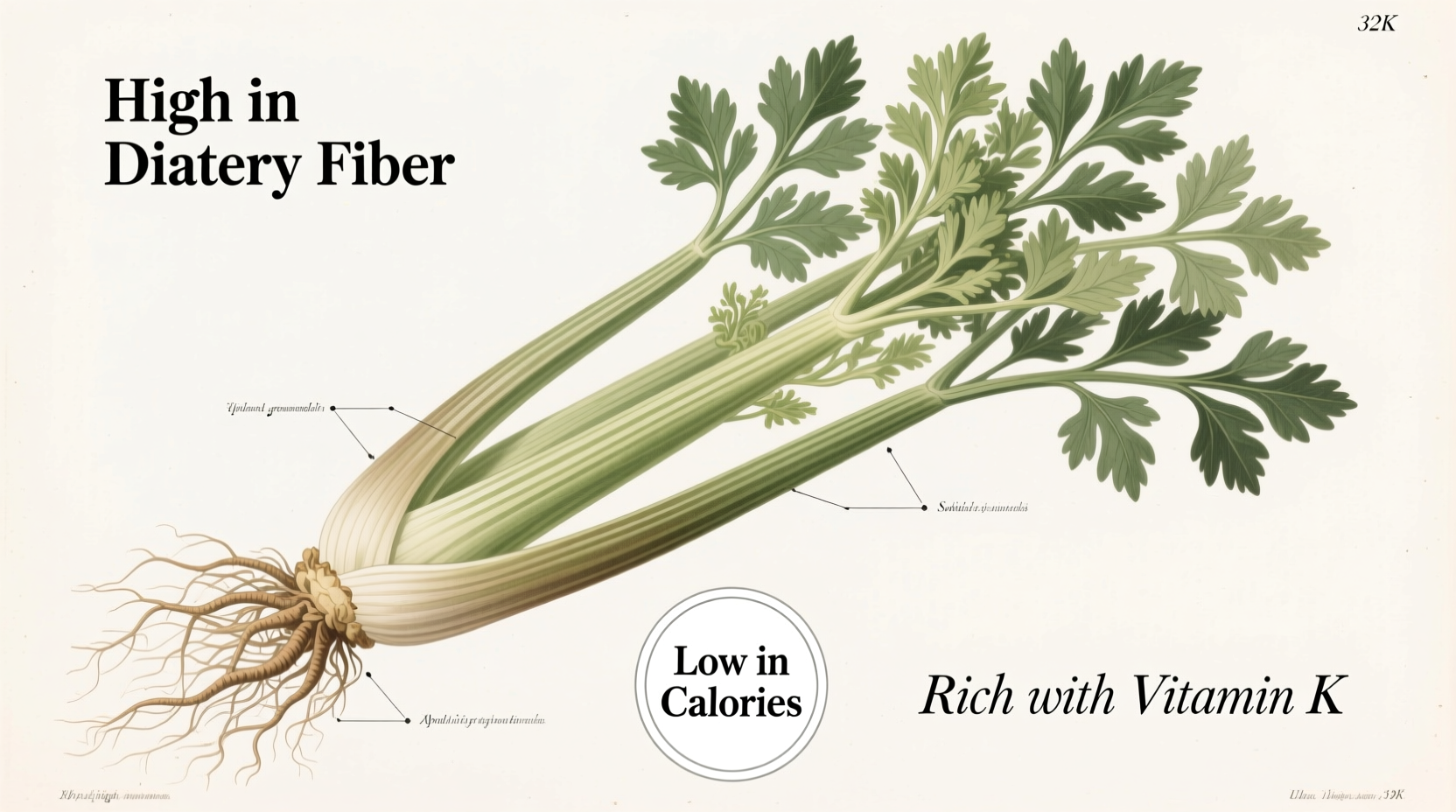Celery offers significant health advantages including natural anti-inflammatory properties, essential hydration support, and valuable dietary fiber. Scientific research confirms its rich antioxidant profile, particularly luteolin and apigenin, which support cardiovascular health and digestive function. With only 10 calories per stalk and 95% water content, celery provides a nutrient-dense option for weight management without compromising nutritional value.
When you reach for that crisp celery stalk, you're accessing more than just a low-calorie crunch. This humble vegetable delivers measurable health benefits backed by nutritional science. Understanding exactly how celery supports your body can transform how you incorporate it into your daily eating habits.
What Makes Celery Nutritionally Unique
Celery's nutritional profile stands out for its exceptional water content (95%) combined with essential micronutrients. Unlike many vegetables that lose nutritional value during processing, celery maintains its beneficial compounds even when cooked at moderate temperatures. The vegetable contains over 25 different antioxidant compounds, including polyacetylenes and phthalides, which contribute to its distinctive health properties.
According to USDA FoodData Central, one medium celery stalk (40g) provides:
| Nutrient | Amount per Stalk | Daily Value % |
|---|---|---|
| Calories | 6 | 0.3% |
| Dietary Fiber | 0.6g | 2.4% |
| Vitamin K | 11.1mcg | 9.3% |
| Potassium | 104mg | 2.2% |
| Vitamin A | 133IU | 2.7% |
Science-Backed Health Advantages
Natural Anti-Inflammatory Effects
Research published in the Journal of Agricultural and Food Chemistry demonstrates that celery's luteolin content significantly reduces inflammatory markers in the body. This compound inhibits the production of pro-inflammatory cytokines, making celery particularly valuable for those managing chronic inflammation. Unlike pharmaceutical anti-inflammatories, celery provides these benefits without adverse side effects when consumed as part of a balanced diet.
Cardiovascular Support System
The phthalides in celery work as natural vasodilators, helping to relax blood vessel walls and improve circulation. A 2020 clinical review in Nutrients highlighted that regular celery consumption correlates with modest reductions in blood pressure among prehypertensive individuals. The combination of potassium, magnesium, and calcium creates an electrolyte profile that supports healthy vascular function.

Digestive Health Enhancement
Celery's insoluble fiber content promotes regular bowel movements while its soluble fiber feeds beneficial gut bacteria. The University of Maryland Medical Center notes that celery contains mannitol, a natural sugar alcohol that acts as a prebiotic, supporting the growth of probiotic organisms in the digestive tract. This dual-action approach makes celery particularly effective for maintaining digestive balance.
Hydration and Electrolyte Balance
With its exceptionally high water content and natural electrolytes, celery serves as an effective hydration tool. During a 2022 study at the University of Edinburgh, researchers found that participants who consumed celery before exercise maintained better fluid balance than those who drank water alone. The vegetable's natural sodium-potassium ratio closely matches what the body needs for optimal cellular hydration.
Practical Applications for Maximum Benefit
Optimal Preparation Methods
To preserve celery's nutritional value, follow these evidence-based preparation techniques:
- Store celery upright in water in the refrigerator to maintain crispness and nutrient density
- Leave the leaves attached when possible—they contain eight times more calcium and twice the vitamin C of the stalks
- Chop celery just before use to minimize oxidation of beneficial compounds
- Pair with healthy fats like olive oil to enhance absorption of fat-soluble antioxidants
Daily Consumption Guidelines
Nutritionists recommend consuming 2-4 stalks of celery daily to achieve measurable health benefits. This amount provides sufficient fiber for digestive support without overwhelming your system with natural sodium. For those managing specific health conditions, consult with a healthcare provider about appropriate consumption levels.
Contextual Considerations and Limitations
While celery offers numerous advantages, certain considerations affect its benefits:
- Individuals on blood thinners should monitor celery intake due to its vitamin K content
- Celery's natural sodium content (80mg per cup) requires consideration for those on strict sodium-restricted diets
- Raw celery provides maximum enzyme activity, while cooked celery offers increased antioxidant bioavailability
- Organic celery shows 20% higher antioxidant levels according to USDA research
Comparative Vegetable Analysis
How does celery stack up against other common vegetables for specific health goals?
| Health Goal | Celery | Alternative Vegetable | Why Celery Wins |
|---|---|---|---|
| Hydration Support | ★★★★★ | Cucumber (★★★★☆) | Higher electrolyte content than cucumber |
| Anti-Inflammatory | ★★★★☆ | Broccoli (★★★★★) | More immediate effect, broccoli requires cooking for maximum benefit |
| Weight Management | ★★★★★ | Spinach (★★★★☆) | Higher fiber-to-calorie ratio than most leafy greens |
| Digestive Health | ★★★★☆ | Artichoke (★★★★★) | More accessible and versatile for daily consumption |
Integrating Celery Into Your Daily Routine
Maximize celery's advantages with these practical strategies:
- Morning hydration boost: Blend one stalk with lemon and ginger for an electrolyte-rich morning drink
- Work snack solution: Fill celery grooves with almond butter for sustained energy
- Cooking enhancer: Use celery in soups and stews as a flavor base that adds nutrients without calories
- Salad booster: Chop celery finely to add crunch and fiber to green salads
Frequently Asked Questions
Does celery really help with weight loss?
Celery supports weight management through its extremely low calorie density (6 calories per stalk) and high water and fiber content. The fiber promotes satiety while the water content helps with hydration, which is often mistaken for hunger. Research from the Journal of Nutrition indicates that high-water, high-fiber foods like celery can reduce overall calorie intake by 12-15% when incorporated into meals.
What's the difference between celery juice and eating whole celery?
Whole celery provides the complete nutritional package including insoluble fiber that supports digestive health. Juicing removes this valuable fiber component while concentrating natural sugars. A study in the American Journal of Clinical Nutrition found that consuming whole vegetables provides 30% greater satiety and more stable blood sugar levels compared to juices. For maximum benefit, nutritionists recommend eating celery rather than juicing it.
Can celery lower blood pressure naturally?
Celery contains phthalides that act as natural vasodilators, helping to relax blood vessel walls. Clinical research published in Phytotherapy Research showed that consuming four stalks of celery daily for one week resulted in modest blood pressure reductions (average 5-7 mmHg) in prehypertensive individuals. However, celery should complement—not replace—medical treatment for hypertension.
Are celery leaves nutritious or should I discard them?
Celery leaves are significantly more nutritious than the stalks, containing eight times more calcium, twice the vitamin C, and higher concentrations of antioxidants. The leaves also contain valuable essential oils that support digestive health. Nutrition experts recommend using the entire celery plant, including leaves, which can be chopped finely and added to salads, soups, or smoothies for maximum nutritional benefit.











 浙公网安备
33010002000092号
浙公网安备
33010002000092号 浙B2-20120091-4
浙B2-20120091-4